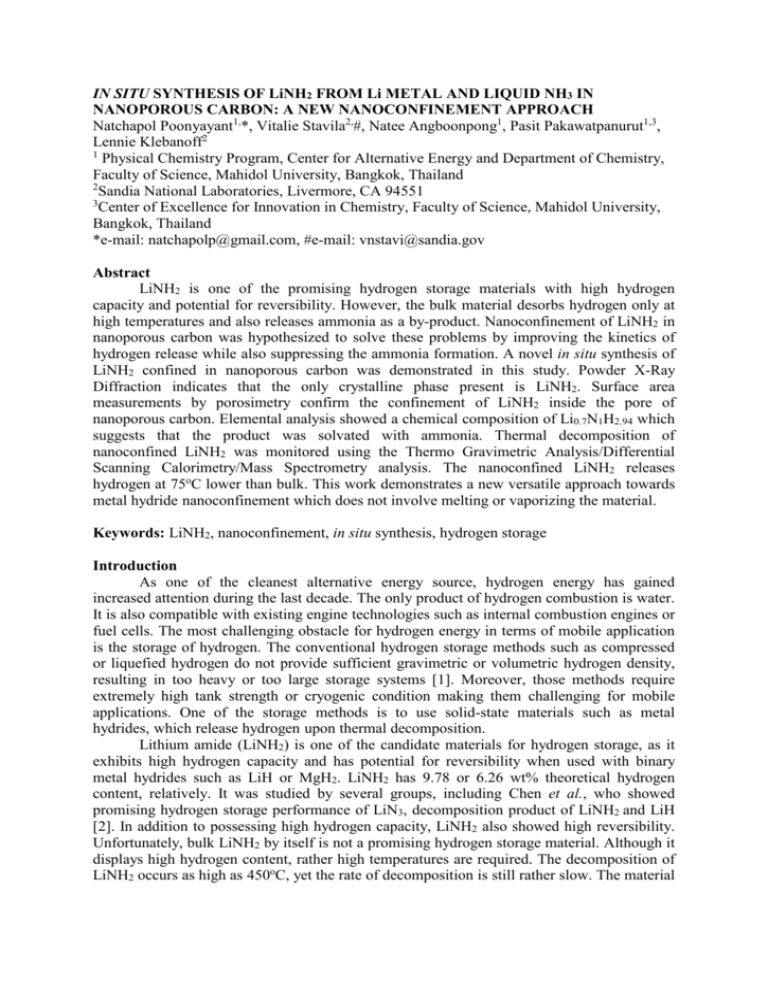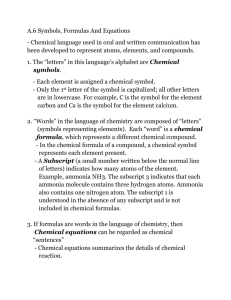Angsana New 16 pt, bold
advertisement

IN SITU SYNTHESIS OF LiNH2 FROM Li METAL AND LIQUID NH3 IN NANOPOROUS CARBON: A NEW NANOCONFINEMENT APPROACH Natchapol Poonyayant1,*, Vitalie Stavila2,#, Natee Angboonpong1, Pasit Pakawatpanurut1,3, Lennie Klebanoff2 1 Physical Chemistry Program, Center for Alternative Energy and Department of Chemistry, Faculty of Science, Mahidol University, Bangkok, Thailand 2 Sandia National Laboratories, Livermore, CA 94551 3 Center of Excellence for Innovation in Chemistry, Faculty of Science, Mahidol University, Bangkok, Thailand *e-mail: natchapolp@gmail.com, #e-mail: vnstavi@sandia.gov Abstract LiNH2 is one of the promising hydrogen storage materials with high hydrogen capacity and potential for reversibility. However, the bulk material desorbs hydrogen only at high temperatures and also releases ammonia as a by-product. Nanoconfinement of LiNH2 in nanoporous carbon was hypothesized to solve these problems by improving the kinetics of hydrogen release while also suppressing the ammonia formation. A novel in situ synthesis of LiNH2 confined in nanoporous carbon was demonstrated in this study. Powder X-Ray Diffraction indicates that the only crystalline phase present is LiNH2. Surface area measurements by porosimetry confirm the confinement of LiNH2 inside the pore of nanoporous carbon. Elemental analysis showed a chemical composition of Li0.7N1H2.94 which suggests that the product was solvated with ammonia. Thermal decomposition of nanoconfined LiNH2 was monitored using the Thermo Gravimetric Analysis/Differential Scanning Calorimetry/Mass Spectrometry analysis. The nanoconfined LiNH2 releases hydrogen at 75oC lower than bulk. This work demonstrates a new versatile approach towards metal hydride nanoconfinement which does not involve melting or vaporizing the material. Keywords: LiNH2, nanoconfinement, in situ synthesis, hydrogen storage Introduction As one of the cleanest alternative energy source, hydrogen energy has gained increased attention during the last decade. The only product of hydrogen combustion is water. It is also compatible with existing engine technologies such as internal combustion engines or fuel cells. The most challenging obstacle for hydrogen energy in terms of mobile application is the storage of hydrogen. The conventional hydrogen storage methods such as compressed or liquefied hydrogen do not provide sufficient gravimetric or volumetric hydrogen density, resulting in too heavy or too large storage systems [1]. Moreover, those methods require extremely high tank strength or cryogenic condition making them challenging for mobile applications. One of the storage methods is to use solid-state materials such as metal hydrides, which release hydrogen upon thermal decomposition. Lithium amide (LiNH2) is one of the candidate materials for hydrogen storage, as it exhibits high hydrogen capacity and has potential for reversibility when used with binary metal hydrides such as LiH or MgH2. LiNH2 has 9.78 or 6.26 wt% theoretical hydrogen content, relatively. It was studied by several groups, including Chen et al., who showed promising hydrogen storage performance of LiN3, decomposition product of LiNH2 and LiH [2]. In addition to possessing high hydrogen capacity, LiNH2 also showed high reversibility. Unfortunately, bulk LiNH2 by itself is not a promising hydrogen storage material. Although it displays high hydrogen content, rather high temperatures are required. The decomposition of LiNH2 occurs as high as 450oC, yet the rate of decomposition is still rather slow. The material is also known to release ammonia along with hydrogen, which is detrimental to both capacity and purity of hydrogen stream. In order to improve the kinetics of the metal hydride decomposition reaction, an efficient approach is to increase the surface area of the solid to generate more reacting surfaces. To push the limits of this improvement, the hydride particle size should be reduced down to the nanometer scale, sometimes less than 10 nm. This raises a question on how to create reacting surfaces at nanoscale. One approach is to use an appropriate nanoscale framework or host. To date solution impregnation and melt infiltration are the methods of choice to achieve a nanostructured metal hydride inside the pores of a nanoscale framework. In the work of Z. Li and coworkers, ammonia borane was nanoconfined in porous metalorganic framework (MOF) JUC-32-Y [3]. Ammonia borane was dissolved in methanol and was impregnated as a solution in the MOF pores. The confined ammonia borane decomposes 70oC lower than bulk material. JUC-32-Y nanoscale template was found to prevent the formation of ammonia, diborane, and borazine from ammonia borane during hydrogen desorption. Stavila et al. demonstrated melt infusion of NaAlH4 into MOF-74(Mg) at 195oC under 25 MPa H2 pressure [4]. The high H2 pressure was used to avoid the decomposition of NaAlH4 upon heating. The MOF-confined NaAlH4 particles showed large improvement in desorption kinetics compared to bulk NaAlH4. Vapor deposition can also be used, for example Stavila et al. showed that TiCl4 can penetrate the MOF-74(Mg) pores in vapor phase and acts as a catalyst for the rehydrogenation of NaAlH4 [4]. We decided to explore the hydrogen storage characteristics of nanoconfined LiNH2. Unfortunately, the common synthetic approaches described to date are impractical for LiNH2, as the material is non-volatile and does not dissolve in common solvents. Even if it could be dissolved, the remaining solvent would be too hard to remove without decomposing the hydride. LiNH2 has a high melting point, not to mention the need for high hydrogen pressure to suppress hydrogen desorption. This inspired us to seek for new approach for nanoconfinement of LiNH2. Lagowski showed that Li could be dissolved in ammonia in form of Li+(NH3)x + e(NH3)x [5]. It is known that Li metal slowly reacts with ammonia to form LiNH2. We hypothesized that Li could be dissolved and impregnated in a porous template; LiNH2 could be synthesized in situ from Li metal and liquid ammonia inside the pores of an appropriate framework. The host selected for this purpose was the chemically stable nanoporous carbon (npC). The advantage of npC lies in its high thermal and chemical stability which prevents any side reactions with the hydride or hydrogen upon heating. npC pore of ~2 nm was expected to be small enough to provide nanoconfinement effect. Interestingly, liquid ammonia served as both solvent for Li and reactant for the LiNH2 synthesis simultaneously. Moreover, ammonia could be removed from the reaction simply and efficiently at room temperature resulting in a pure reaction product. We hypothesized that LiNH2 confined in npC (LiNH2@npC) will exhibit improvement of hydrogen storage properties from nanoconfinement effect such as lower decomposition temperature and suppression of ammonia desorption. Methodology Synthesis of nanoporous carbon: 90 g of tetraethyl orthosilicate was added in small portions to a suspension of 45 g poly(ethylene glycol)-block-poly(propylene glycol)-blockpoly(ethylene glycol) (Pluronic P123) in 300 mL of 0.5 M hydrochloric acid solution and the mixture was stirred for 4 hours. The resulting gel was aged at 60oC for 16 hours and heated in the oven at 90oC for 4 hours. After this, the obtained solid was calcined in an oven in air at 600oC for 16 hours to decompose the triblock copolymer and form mesoporous silica. The ascalcined silica was added to 200 mL 50 wt% solution of sucrose in water and the mixture was stirred for 30 min. The solvent was removed using a rotary evaporator and all the resulting solid was calcined at 600oC under nitrogen for 16 hours to form a solid block which was fractured into smaller pieces. In a plastic beaker, the resulting mesoporous silica/carbon composite was treated with excess 2 wt% HF solution in water to dissolve the silica. The solid was washed 5 times with EtOH to remove excess acid. Finally, the product was dried in vacuum (20 mTorr) at 250oC for 16 hours to yield activated nanoporous carbon. In situ synthesis of nanoconfined LiNH2: In a typical synthesis of LiNH2@npC, 0.360 g of Li metal (99%, Aldrich) was placed in a Schlenk tube containing 3.109 g activated npC inside of a glove-box. The tube was then cooled in dry ice/acetone bath. In continuous flow of Ar, anhydrous ammonia gas (Matheson, Ultra-High purity) was fed into the tube until it condensed ~20 mL liquid and covered all Li and npC solid. The bath was kept cold for 30 min. After that, the reaction flask was left under a constant Ar flow so that liquid ammonia could slowly evaporate while the temperature increased to room temperature overnight. Excess ammonia gas was trapped with HCl acid before it was vented. LiNH2@npC was recovered and weighted in a glove-box. Characterization: The samples were grounded and loaded into glass capillaries which were then sealed with vacuum grease in a glove-box for Powder X-Ray Diffraction (PXRD) characterization. The measurements were performed on a Panalytical Empyrean diffractometer equipped with a Cu target. Gas adsorption experiments were performed on a QuantaChrome Quadrasorb-SI porosimeter. Simultaneous Thermo Gravimetric Analysis/Differential Scanning Calorimetry/ Mass Spectrometry (TGA/DSC/MS) experiments were performed on Mettler TGA/DSC-1 STARe system equipped with Pfeiffer Mass Spectrometer. In each TGA/DSC/MS experiment ~ 10 mg of sample was sealed in aluminum crucible under Ar atmosphere. It was heated from 30 – 600oC with 5oC/min heating rate under Ar flow of 5 ml/min. Elemental analysis was done at ALS Environmental. Results Nanoporous Carbon (npC) was used as a host for LiNH2 mainly due to its chemical inertness. It comprises of more than 90 wt% carbon making it stable up to temperatures in excess of 600oC. It has a higher chemical and thermal stability compared to MOFs. This allows us to synthesize LiNH2 with npC without the doubt if there would be any side reactions with the template. It also has highly porous structure with the pore size of ~ 2 nm in diameter, which makes it convenient to study the nanoconfinement effects in metal hydrides. LiNH2 was synthesized in situ from Li metal and liquid ammonia with the presence of npC as shown in Scheme 1. Li metal was dissolved by liquid ammonia and was absorbed into the nanoporous structure of the npC. Scheme 1 Reaction of Li metal and liquid ammonia in the presence of npC The initial calculated Li metal amount was 20.56% of total pore volume and was equivalent to the volume of LiNH2 that can fill 30.62% of npC pore volume. This was done to minimize the formation of bulk LiNH2 outside of npC pores. Liquid ammonia was maintained for 30 minutes and the Schenk tube was shook occasionally to make sure Li was completely dissolved. When liquid ammonia was evaporated, solvated Li(NH3)x was converted into LiNH2 in the npC pores yielding nanoconfined LiNH2. Initial Li metal pieces were not observed in the final product which is a sign that Li is infiltrated in the npC pores. Also the nanoconfined npC was more brittle than original npC which might be resulted from LiNH2 penetration into npC structure. The surface of npC was lightly covered with white powder that is possibly LiNH2. PXRD patterns of nanoconfined npC (Figure 1) showed LiNH2 peaks as the only crystalline phase in the sample. The PXRD results confirm the successful Intensity (a.u.) synthesis of LiNH2 in the presence of npC. The PXRD pattern of nanoconfined LiNH2 matched that of bulk LiNH2. This crystalline peaks could be from ordered LiNH2 inside the pores or alternatively from material outside the pores. (b) (a) 10 20 30 40 50 2θ 60 70 80 90 Figure 1 PXRD patterns of (a) LiNH2 and (b) LiNH2@npC To determine where LiNH2 is localized, gas adsorption experiments were performed and results are shown in Table 1. From these results that the surface area and pore volume of npC decreased by 77% indicates that the synthesized LiNH2 was mostly in the pore of npC. Due to the fact that interior surface area of npC is tremendously larger than its exterior surface area, it is reasonable to say that most of LiNH2 formed in the porous structure of npC rather than forming as bulk LiNH2. Technically LiNH2 was supposed to fill only 30% of total pore volume according to initial Li loading. A reasonable explanation behind this discrepancy can be that the final product LiNH2 only filled the npC pores partially and blocked some accessible pore volume, leaving some void in the pores, which could result in more pore volume filling than expected. Loading of LiNH2 was calculated from the summary of Li, N, and H wt% from elemental analysis (Table 1). Empirical formula of Li-N-H compound in the nanoconfined sample was also derived from elemental analysis. The ratio of N to Li is more than 1:1 suggesting that there could be some solvated NH3 left in the sample. The temperature for removing the solvated NH3 should not release hydrogen from LiNH2@npC. To investigate the LiNH2@npC decomposition, simultaneous TGA/DSC/MS was used. Table 1 BET surface area and total pore volume from gas adsorption experiments, loading and empirical formula from elemental analysis Sample Activated npC LiNH2@npC BET surface area (m2/g) 1058.1 241.2 Total pore volume (mL/g) 1.062 0.238 Loading (wt%) 28.33 Empirical Formula Li0.70N1H2.94 Thermal decomposition of nanoconfined sample was studied in comparison to bulk LiNH2 using TGA/DSC/MS (Figure 2). This simultaneous technique allows us to correlate sample weight loss, enthalpy of reaction, and type of released gas. There was no weight loss from bulk LiNH2 until 330°C where it started losing 2.2 wt% as NH3. DSC showed sharp and large endothermic peak at 362°C for this weight loss. The loss of large 23.8 wt% in the temperature range of 455 °C to 600°C was from H2 release along with NH3. This step started with a sharp endothermic peak followed by multiple exothermic peaks. LiNH2@npC released NH3 at low temperature ranged from 65 – 350 °C correspond to 8.8 wt% loss from TGA. Considering 28.33 wt% LiNH2 loading, the weight loss was equivalent to 31.06 wt% from only the LiNH2 component. The broad peak and the low temperature of desorption suggested the NH3 loss should be from solvated NH3. In addition, if it were a reaction, there should have been a corresponding DSC peak present. Surprisingly, some H2 gradually evolved at this rather low temperature region as well. The reason for this low temperature H2 release may be the altered thermodynamics of the reaction due to nanoconfinement effects. Interestingly, LiNH2@npC released H2 at 380 – 485 °C along with NH3. This desorption started 75°C lower than bulk LiNH2, and finished more than 100 °C lower than bulk. Moreover, the total weight loss in 380 – 485 °C was 2.2 wt%, which was equivalent to 11.30 wt% loss from only LiNH2. Compared to bulk LiNH2, the weight loss was reduced by about half. This suggests that not only nanoconfinement can improve kinetics of LiNH2 decomposition, but it might also reduce the ammonia desorption. The DSC features of the LiNH2@npC sample were weaker than those of bulk LiNH2, which may be due to high npC content; however, it still showed signs of exothermic reactions in the temperature range corresponding to H2 desorption from LiNH2@npC. Weight Loss (wt%) 100 95 (a) 90 85 80 75 Heat Flow (Wg^-1) oC 70 oC 0 5 50 15100 25150 35200 45 250 55 300 65 350 75 400 85 450 95 500 105550 115600 2 ^ exo 0 -2 (b) -4 -6 -8 o -10 0 5 50 15100 25150 35200 45250 55300 65 350 75 400 85 450 95 500 105550 115600 C oC 0 Intensity (a.u.) (c) o 5 50 15100 25150 35200 45250 55300 65350 75400 85450 95500 105550 115600 C oC (d) o 0 5 50 15100 25150 35200 45250 55300 65350 75400 85450 95500 105550 115600 C oC Figure 2 (a) TGA (b) DSC (c) MS m/z = 2 (d) MS m/z = 17 of LiNH2 (solid) and LiNH2@npC (dash); the heating rate is 5°C/min Discussion and Conclusion Nanoporous carbon was found to be a suitable host for the in situ synthesis of nanoconfined LiNH2 due to its high thermal and chemical stability. The pore size of npC was small enough to provide nanoconfinement effect in the scale at which LiNH2 reaction differed largely from bulk. In situ synthesis of LiNH2 from Li metal and liquid NH3 in the presence of npC was successful with PXRD results showing LiNH2 was present. LiNH2 was confirmed to be nanoconfined within npC pores from gas adsorption results showing decrease in total pore volume. Elemental analysis and TGA/DSC/MS measurements indicate that there is solvated ammonia remaining in the nanoconfined material. The change in both H2 and NH3 desorption profiles suggests that the nanoconfinement in npC could significantly improve the kinetics of LiNH2 decomposition and reduces the H2 desorption temperature by 75oC. TGA/DSC/MS data show a 11.30 wt% loss from LiNH2@npC, approx. half of the wt% from bulk LiNH2. This clearly indicates a decrease in the amount of ammonia desorbed as a result of nanoconfinement. However, quantification of H2 and NH3 needs to be done in order to determine hydrogen storage capacity and ammonia concentration in the hydrogen stream. This proposed synthetic approach represents a new synthetic pathway towards nanoconfinement. The new in situ method could be applied for the nanoconfinement of other amide materials in appropriate hosts. References 1. Klebanoff L, editor. Hydrogen storage technology. Boca Raton: Taylor and Francis; 2012. 2. Chen P, Xiong Z, Luo J, Lin J, Tan KL. Interaction of hydrogen with metal nitrides and imides. Nature. 2002;420(6913):302-4. 3. Li Z, Zhu G, Lu G, Qiu S, Yao X. Ammonia Borane Confined by a Metal−Organic Framework for Chemical Hydrogen Storage: Enhancing Kinetics and Eliminating Ammonia. J Am Chem Soc. 2010;132(5):1490-1. 4. Stavila V, Bhakta RK, Alam TM, Majzoub EH, Allendorf MD. Reversible Hydrogen Storage by NaAlH4 Confined within a Titanium-Functionalized MOF-74(Mg) Nanoreactor. ACS Nano. 2012;6(11):9807-17. 5. Lagowski J. Solution Phenomena in Liquid Ammonia. Pure Appl Chem. 1971;25(2):429-56. Acknowledgements: The authors acknowledge Ken Stewart and Joe Cordaro (Sandia National Laboratories) for their technical assistance. Poonyayant, Angboonpong, and Pakawatpanurut acknowledge support from the Development and Promotion of Science and Technology talents project, the Center of Excellence for Innovation in Chemistry (PERCHCIC), and the Distinction Program, Faculty of Science, Mahidol University. This work was supported by the U.S. Department of Energy, Office of Efficiency and Renewable Energy, under Award Nos. DE-AC04-94AL8500. Partial support for this work from The Boeing Company is also greatly appreciated. The authors thank Joe Breit from Boeing for his support of this work.






